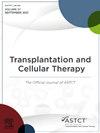Impact of Cytomegalovirus Reactivation Following Allogeneic Hematopoietic Cell Transplantation on the Relapse of Acute Leukemia
IF 4.4
3区 医学
Q2 HEMATOLOGY
引用次数: 0
Abstract
Background
Cytomegalovirus (CMV) reactivation following allogeneic hematopoietic cell transplantation (HCT) is a significant complication; however, its impact on relapse remains controversial.
Objectives
This study aimed to evaluate the clinical impact of CMV reactivation on relapse and survival after HCT in patients with acute leukemia.
Study Design
We conducted a retrospective analysis of 1258 patients diagnosed with acute myeloid leukemia (AML) and acute lymphoblastic leukemia (ALL) who underwent their first HCT between 2000 and 2020.
Results
Our cohort included 871 patients with AML and 387 patients with ALL. Among all patients, 751 (61.6%) experienced CMV reactivation within one year post-HCT. CMV reactivation was associated with HCT from unrelated donors, anti-thymocyte globulin use, and the occurrence of acute graft-versus-host disease. Notably, CMV reactivation was associated with a lower risk of relapse (HR, 0.713; P = .001) and improved event-free survival (HR, 0.743; P = .001) in both AML and ALL patients. However, there was no significant difference in non-relapse mortality or overall survival according to CMV reactivation.
Conclusion
These results suggest that CMV reactivation may prevent post-HCT relapse and enhance event-free survival in AML and ALL patients. Therefore, a CMV prophylaxis strategy is warranted to establish a safe range of CMV reactivation titers that can yield beneficial effects.
异基因造血细胞移植后巨细胞病毒再激活对急性白血病复发的影响。
背景:同种异体造血细胞移植(HCT)后巨细胞病毒(CMV)再激活是一个重要的并发症;然而,它对复发的影响仍然存在争议。目的:本研究旨在评估巨细胞病毒再激活对急性白血病患者HCT后复发和生存的临床影响。研究设计:我们对1258名诊断为急性髓性白血病(AML)和急性淋巴细胞白血病(ALL)的患者进行了回顾性分析,这些患者在2000年至2020年间接受了第一次HCT。结果:我们的队列包括871例AML患者和387例ALL患者。在所有患者中,751例(61.6%)在hct后一年内经历了巨细胞病毒再激活。巨细胞病毒再激活与非亲属供体的HCT、抗胸腺细胞球蛋白的使用和急性移植物抗宿主病的发生有关。值得注意的是,CMV再激活与较低的复发风险相关(HR, 0.713;P=0.001)和无事件生存率的提高(HR, 0.743;P=0.001)。然而,根据CMV再激活,非复发死亡率或总生存率没有显着差异。结论:这些结果表明CMV再激活可以预防AML和ALL患者的hct后复发并提高无事件生存率。因此,CMV预防策略是必要的,以建立一个安全的CMV再激活滴度范围,可以产生有益的效果。
本文章由计算机程序翻译,如有差异,请以英文原文为准。
求助全文
约1分钟内获得全文
求助全文
来源期刊

Transplantation and Cellular Therapy
Medicine-Hematology
CiteScore
7.00
自引率
15.60%
发文量
1061
审稿时长
51 days
 求助内容:
求助内容: 应助结果提醒方式:
应助结果提醒方式:


